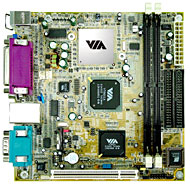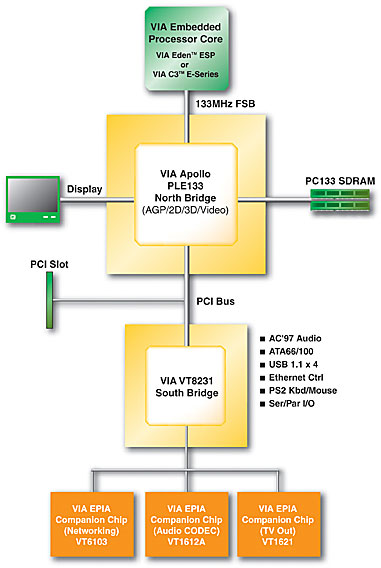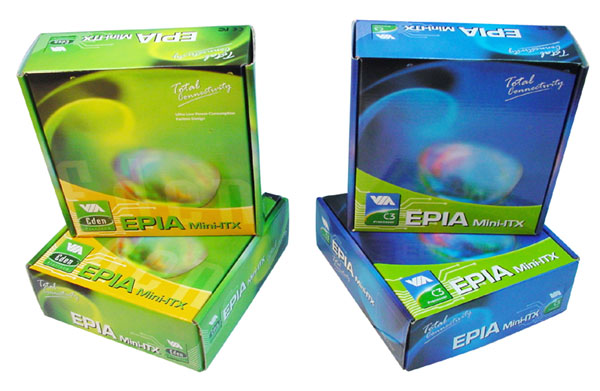
Mini IRLP Node Project
Intro
This project is an attempt to make a small, low power IRLP node with one of the
new "embedded PC's" and Red Hat v7.3 Linux. (Seems appropriate that the
version is "73").
Why bother? Most nodes are built out of older PC's because the processing demand does not require the latest computer hardware and, of course, they are less expensive if not free given a good size junkbox. However, there are some drawbacks. The older PC's tend to be big, noisy, generate a lot of heat and require a 120 VAC for the power supply. The goal of this project is to ultimately eliminate all the moving bits (disk drive, fans), minimize the heat generated and create a small enough package to easily install anywhere and run it off of +12 VDC.
The reason for focusing on Red Hat 7.3 is the motherboard selected offers drivers for 7.2 and 7.3 and not the earlier versions like 6.2.
Hardware
The system is based on a Via EPIA Mini-ITX
motherboard with a low power, fan-less 500 MHz Via Eden ESP processor and Via
chipset. This board has all the makings of a great little IRLP node
because of its size, cost, speed and integration of all key components.
Motherboard

When you look at the real CPU board, you won't see the silver CPU chip because it's covered by a heatsink. There are currently two versions, one based on the 500 MHz Via Eden ESP 500 fan-less CPU and one based on the 800 MHz Via C3 E-Series processor. Everything else is the same. The ESP 500 is lower power and the C3 provides more performance. For IRLP, either should work fine. Cost of the motherboard is about $100.
Sources
|
|
|||||||||||||||||||||||||||||||
Motherboard block diagram

This is what the packages look like in the stores. The green one on the left is the 500 Mhz fan-less CPU, the blue one on the right is the 800 Mhz fan-cooled model. Although when I saw the fan-cooled version, the box was silver!

Chassis
The low power of the Eden CPU and small footprint of the mother board allows for
packaging into this small chassis. With relatively low heat generated by
the CPU, the system requires little cooling which means there is only one small
fan on the back of the chassis. Rather than the usual large, heavy, AC
power supply, the built in power supply runs off of 12 volts DC! All these
factors make the unit small, highly portable and perfect for amateur radio
installations.
More chassis pictures
The chassis is the "Cupid 2677 model and is manufactured by Morex in Taiwan. The chassis measures only 12" x 10" x 2.5". Space is provided for a 5 1/4" Slim CD, 3 1/2" floppy, 3 1/2" hard disk and built-in 12 volt DC-to-DC converter / power supply. Manufacturer: www.procase.com.tw US sources... Case Outlet www.caseoutlet.com 877 390-8888 Computergate www.computergate.com Product link for Casetronics u-ITX-2677
Other hardware sources Cables and other parts www.cablesonline.com
Replacing the full time hard disk
The goal is to eventually replace the hard disk with something that is
quieter, higher reliability, draws less current and generates less heat.
Seems that a compact flash would be great except for the cost and potential
timing problems that others have mentioned getting them to work reliability as a
virtual hard disk. The path we are going down to to use a RAM disk and
spin down the hard disk after the system boots. More details to follow as
we sort this out.
Software
The big experiment is to figure out if it is possible to assemble all the
required drivers and get the system configured to work. Starting out there
are some areas of concern that I have to figure out...
Progress so far...
As I figure out how to make each of these bit work I will update this section. Here is the progress so far...
Hardware configuration
I started with the 533 Mhz fan-less Eden processor, 256 Mb of RAM, 20 Mb
disk, slim CD-ROM and the little Cupid case with 60 watt DC power supply.
This configuration is overkill for an IRLP node but its not much cheaper to
downgrade the hardware unless you get the parts for free. The manual
included with the Via motherboards is very good and walks you through each
connector and jumper on the motherboard. Configuration is a breeze as you
really don't need to change a thing, just plug everything into the right socket.
Software install
After putting the computer together, which is just about as easy as it gets, I
inserted the Red Hat installation CD 1 a booted the computer. The install
disk loaded and after a few clicks to select the various hardware components,
the installer ran for abou one hour and progressed through all 3 of the Red Hat
7.3 installation CDs. When the system installation was done, the machine
was rebooted and there it was... the Red Hat Linux login prompt. I logged
in and there I was in the Linux Gnome GUI! Hey, this is too easy.
Although the IRLP node does not need all the Linux graphic UI an other
installation software, it is a good way to check out the computer to make sure
everything is working. I launched the Netscape browser and surfed the web
so I know the ethernet port works and obviously the display, keyboard and mouse
drivers work. The last check was the built in AC97 compliant audio chip.
I dropped a CD with some MP3 files in the CD ROM drive and ran the Linux MP3
player that comes with Red Hat and guess what? I get an error and can't
hear anything. I go into the MP player driver window, select the OSS
output audio driver that came built in to RH and now I hear music!
So without installing any special drivers, the off the shelf Red Hat 7.3 installed easily and works 100% as a desktop Linux machine should running on the Via motherboard.
Software resources
Your input welcomed!
If you have any thoughts, comments, suggestions, ideas, or words of encouragement, please feel free to email George KJ6VU.